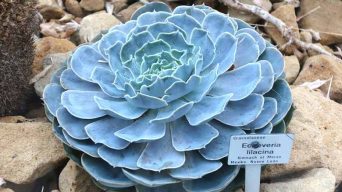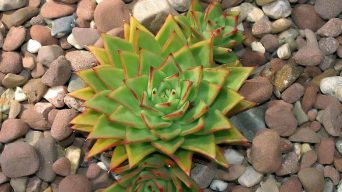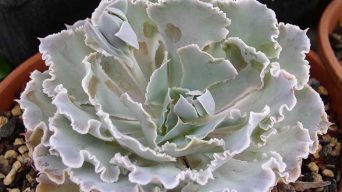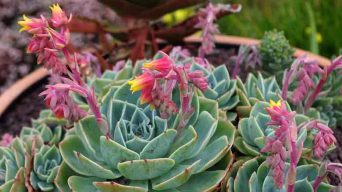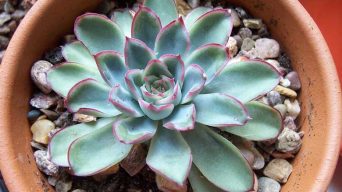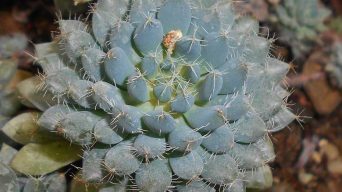Growing Echeverias in your garden or outdoor space is a beautiful way to add color and texture.
These plants are low maintenance and easy to grow, making them perfect for just about any gardener.
Echeveria colorata is one of the most popular Echeveria varieties available. These plants are very versatile and flexible.
They can be used as an accent plant, in contrast to other varieties of succulents, or even by themselves.
It is also one of the easiest varieties to grow since it has no real care requirements once you acclimate it into your environment.
Below, we’ll go over a detailed care guide that will help you keep your Echeveria colorata healthy and happy.
Overview
Echeveria colorata is a flowering plant in the family Crassulaceae that is indigenous to Mexico.
This type of succulent plant has rosettes of pale green, arching leaves with a red-tipped edge.
Rosettes can grow as big as 16 inches (40 cm) in diameter, although they average 8 inches (20 cm) across.
From late summer through the fall, arching stems bear pink flowers.
How To Care for Echeveria Colorata
Echeveria colorata care is easy if you provide the proper environment and basic necessities.
Below you’ll find the essential information you need to know about caring for Echeveria colorata.
Sun Exposure & Light Requirements
Echeveria colorata is a succulent plant that needs full sun to partial shade. It is easier to keep the plant in bright, indirect light.
They tend to get sunburned and rot faster if you give them direct sunlight.
Remember that Echeveria colorata gets damaged by intense heat from above, so if you have a south-facing window, place it near the wall or away from the windows.
A west or east-facing window is ideal for this plant because they get early morning and late afternoon sunlight with no intense heat from the sun.
If you still think your window is too sunny, use a sheer curtain to filter out some light.
Watering Requirements
Echeveria plants need to be watered weekly. If the soil feels dry, give them a light watering.
You can also check by inserting a finger into the potting soil about an inch down to see if it’s dry or not. If it isn’t, don’t water.
If you are unsure if the soil is moist enough or not, you can check by sticking your finger an inch down into the potting soil.
You should be able to get a little dirty without having it show up on your finger when wet. If there’s no moisture visible in the potting soil, lightly water it.
Be careful not to overwater Echeveria colorata succulents because they will rot and die if you do.
They only need to be watered once a week on average, but in hotter weather or if they’re indoors next to the window, they may need to be watered twice a week.
In addition, avoid watering in the middle of the day because it will be the least effective time to water your Echeveria colorata succulents.
It’s best to water them in the morning or evening, preferably the latter.
Soil Requirements
Echeveria colorata, like most other succulent plants, prefers to grow in fast-draining soil.
This means that the soil should be porous and absorb water fast. This also means that you should avoid planting your Echeveria in heavy and dense soil.
A cactus soil mix is a good option if you want to plant your Echeveria in soil. You can also add perlite or sand to the cactus soil, making the soil lighter and airier.
If you do not want to use a cactus soil mix or prefer a more natural approach to your gardening, you can create a fast-draining soil for your Echeveria yourself.
To do this, you can mix equal parts of sand and perlite with your regular potting soil to create a cactus soil mix.
This will ensure that your Echeveria colorata will have a well-draining soil bed.
Temperature and Humidity
Echeveria colorata is a succulent plant; thus, it is vital to provide this plant with a suitable temperature and humidity.
Echeveria colorata succulents do best in temperatures between 65-80 degrees Fahrenheit, typically maintained indoor temperatures.
In cooler climates, you should place your Echeveria colorata in a location that provides shade from the sun throughout the day.
Echeveria colorata can tolerate slightly lower temperatures, but you should try not to let the temperature drop below 50 degrees.
It does best in dry environments and doesn’t like wet, humid climates.
The humidity should be pretty low if you grow your plant in a greenhouse. Echeveria colorata does best when the humidity hovers around 40%.
For those who like to keep a humidifier running in their homes, make sure that your Echeveria colorata is not exposed to too much moisture.
Fertilizing
Echeveria colorata plants don’t need to be fertilized too often.
An excellent time to fertilize is during the growing seasons, in spring and summer. During winter, they don’t need to be fertilized.
But during the growing seasons, you can use a balanced liquid fertilizer diluted to half-strength once every two weeks.
But remember that too much fertilizer can be harmful to the plant, so fertilize less to see the result.
Also, remember not to pour the fertilizer straight into the plant.
Instead, pour a bit of water first onto the soil and then add the fertilizer to it so that its nutrients will spread around better throughout the soil.
Potting and Repotting
Echeveria colorata is happy to grow in the same pot for years but will eventually need repotting.
The best time to do this is when the plant has filled its current container or looks like it is struggling to stay in its pot.
To repot Echeveria plants, remove the plant from its current container, gently shake off old soil from the roots, and place it in a larger container filled with fresh potting soil.
Be sure to allow the top of the root ball to sit about an inch below the rim.
Don’t water the plant for a few days to allow the soil to settle and the roots to recuperate.
The best pot types for Echeveria colorata are terracotta and unglazed pots with drainage holes.
Use well-draining potting soil when repotting Echeveria colorata.
To prevent the plant from getting too big for its container, repot it in a container one size larger each time you notice that the roots are starting to fill the current pot.
Pruning
Echeveria colorata is a slow-growing succulent and therefore does not need to be pruned.
Like most other succulent plants, Echeveria colorata prefers to be left alone.
You can prune it if you want to get rid of brown or yellow leaves, but make sure to leave at least one (non-brown/yellow) alternate leaf below the area you are cutting.
Also, removing damaged and dead leaves help prevent the spread of any diseases.
Pests and Diseases
Although this Echeveria is generally pest and disease-free, it can be affected by pests or diseases if not properly taken care of.
Some possible problems include:
Mealybugs
Mealybugs are the most common pest to affect this kind of Echeveria.
They can be recognized by their white, powdery appearance and wax secretions.
If you find any of these signs, isolate affected areas and use cotton dipped in rubbing alcohol to remove the insects.
You can also use white vinegar to get rid of them.
Aphids
Aphids are tiny, pear-shaped insects that come in black, brown, green, and yellow colors.
You can usually find them sucking sap from stems, buds, or undersides of leaves.
If you see any signs of aphids, use cotton swabs dipped in rubbing alcohol to remove the insects or spray them with insecticidal soap.
Scale Insects
It is not uncommon for this kind of Echeveria to be affected by scale insects, tiny parasites that feed on plant sap.
You may find these little bugs in clusters on the stem, leaf axils, and undersides of leaves.
Insecticidal soap may be used to get rid of them.
Powdery Mildew
A type of fungus causes powdery mildew and can affect the appearance of your Echeveria.
When it infects the leaves and stems, the part affected will feel like it has a soft, chalky surface.
You should isolate infected areas to prevent further spread.
The easiest way to get rid of powdery mildew is by using baking soda or neem oil.
Root Rot
Root rot is a problem that occurs when the roots of a plant are infected with mold or fungus.
You may see wilting, browning of leaf tips, and other signs to indicate this kind of infection.
If your Echeveria is infected, remove the affected parts and try to remove the mold using a fungicide.
How to Care for Echeveria Colorata in Winter
Although the Echeveria Colorata succulent plant does well outdoors in temperate and tropical-like climates, it is not tolerant of frost.
If you live in the northern hemisphere and it gets cold during winter, it is important to bring Echeveria Colorata inside.
You can move your plant outside after all danger of frost has passed and the temperature remains above 50 degrees Fahrenheit (10 degrees Celsius).
Make sure it gets lots of bright, indirect sunlight during the day. At night, place your Echeveria Colorata in a warm, brightly lit room where temperatures do not fall below 60 degrees Fahrenheit (15 degrees Celsius).
To keep these plants happy and healthy during winter, reduce watering to once a month and place them in a sunny location.
This would be ideal if you have a place indoors where there is lots of bright light, yet the temperature remains between 60 and 70 degrees Fahrenheit (15 to 21 degrees Celsius).
How To Propagate Echeveria Colorata
Echeveria colorata may be propagated from leaf, stem cuttings, or offsets.
Propagating Echeveria Colorata from Leaves
Propagating Echeveria from leaves is the most common method.
Remove a leaf that has just fallen off to start Echeveria colorata propagation, or gently pull one long leaf from the rosette.
Let the leaf dry for two days and place it in a small pot filled with cactus and succulent soil.
Keep the leaf in a shaded area for about two weeks, watering when the soil is dry.
Soon new roots will grow from the leaf, and the plant will begin to grow.
Keep the young Echeveria in a shaded area and water as needed.
Propagating Echeveria Colorata from Stems Cuttings
Echeveria colorata may be propagated from stem cuttings; however, it is more difficult than leaf propagation.
Cut a stem from the echeveria plant at least one inch long to propagate Echeveria from stem cuttings.
Place it in a small pot filled with cactus and succulent soil.
Keep the cutting in the sun for several days but keep the soil moist.
New roots will grow if successful propagation is achieved.
When new growth appears, plant in its permanent location in well-drained soil and in the sun, and water as needed.
Propagating Echeveria Colorata from Offsets
You may propagate Echeveria colorata by separating offsets, which can be very successful.
Offsets are essentially plantlets that grow on the base of the mother plant. The offsets can be removed and planted as another adult plant.
To separate offsets for propagation, remove the offsets with a sharp knife or pruning shears.
Allow cuttings to dry in a shady area for two days.
Plant offsets in cactus and succulent soil with the flat side down, pointing up.
Keep the soil moist but not soggy, and keep the plant shaded for two weeks.
Place it in the sun when new growth appears and continue to water as needed.
Final Thoughts
Growing Echeveria colorata is simple if the proper practices are followed.
This is not a particularly difficult succulent to take care of, but it must be appropriately watered with good drainage.
The plant grows slowly, but this depends on the growing conditions.
If you follow these directions for Echeveria colorata care, your succulent should stay healthy, vibrant, and beautiful.


